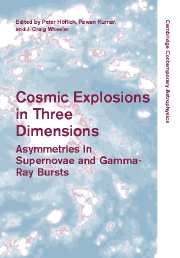Book contents
- Frontmatter
- Contents
- Part I Introduction
- Part II Supernovae: Observations Today
- Part III Theory of Thermonuclear Supernovae
- 10 Semi-Steady burning evolutionary sequences for CAL 83 and CAL 87: Super Soft X-ray binaries are supernova Ia progenitors
- 11 Type Ia progenitors: effects of spin-up of white dwarfs
- 12 Terrestrial combustion: feedback to the stars
- 13 Non-spherical delayed detonations
- 14 Numerical simulations of Type Ia supernovae: deflagrations and detonations
- 15 Type Ia supernovae: spectroscopic surprises
- 16 Aspherity effects in supernovae
- 17 Broad lightcurve SNe Ia: asymmetry or something else?
- 18 Synthetic spectrum methods for three-dimensional supernova models
- 19 A hole in Ia? Spectroscopic and polarimetric signatures of SN Ia asymmetry due to a companion star
- 20 Hunting for the signatures of 3-D explosions with 1-D synthetic spectra
- 21 On variations in the peak luminosities of Type Ia supernovae
- Part IV Theory of Core Collapse Supernovae
- Part V Magnetars, N-Stars, Pulsars
- Part VI Gamma-ray Bursts
- Part VII Conference Summary
- References
10 - Semi-Steady burning evolutionary sequences for CAL 83 and CAL 87: Super Soft X-ray binaries are supernova Ia progenitors
Published online by Cambridge University Press: 11 August 2009
- Frontmatter
- Contents
- Part I Introduction
- Part II Supernovae: Observations Today
- Part III Theory of Thermonuclear Supernovae
- 10 Semi-Steady burning evolutionary sequences for CAL 83 and CAL 87: Super Soft X-ray binaries are supernova Ia progenitors
- 11 Type Ia progenitors: effects of spin-up of white dwarfs
- 12 Terrestrial combustion: feedback to the stars
- 13 Non-spherical delayed detonations
- 14 Numerical simulations of Type Ia supernovae: deflagrations and detonations
- 15 Type Ia supernovae: spectroscopic surprises
- 16 Aspherity effects in supernovae
- 17 Broad lightcurve SNe Ia: asymmetry or something else?
- 18 Synthetic spectrum methods for three-dimensional supernova models
- 19 A hole in Ia? Spectroscopic and polarimetric signatures of SN Ia asymmetry due to a companion star
- 20 Hunting for the signatures of 3-D explosions with 1-D synthetic spectra
- 21 On variations in the peak luminosities of Type Ia supernovae
- Part IV Theory of Core Collapse Supernovae
- Part V Magnetars, N-Stars, Pulsars
- Part VI Gamma-ray Bursts
- Part VII Conference Summary
- References
Summary
Introduction
The assumption commonly made is that Supernovae of Type Ia (SN Ia) are the result of thermonuclear runaways (TNR) in the cores of carbon-oxygen white dwarfs (WD) which are members of binary systems and have accreted material from a companion until their masses exceed the Chandrasekhar Limit (Leibundgut 2000, 2001). However, the binary star systems that end in this explosion are not yet known although there have been numerous proposals. Nevertheless, the importance of SN Ia, both to our understanding of the evolution of the Universe and to the formation of iron in the Galaxy, demands that we determine the progenitors of these explosions.
Originally proposed by Whelan and Iben (1973), virtually every type of close binary which contains a WD has been suggested at one time or another. However, based purely on observational concerns, most of the systems that have been proposed cannot be the progenitors (Starrfield 2003). For example, one of the first suggestions was a classical nova system (CN), but the amount of core material ejected during the outburst implies strongly that the WD is losing mass as a result of the outburst (Gehrz et al. 1998). Other suggestions such as Symbiotic Novae (T CrB or RS Oph, for example) can probably be ruled out.because there is too much hydrogen present in the system (the explosion takes place inside the outer layers of a red giant) and the defining characteristic of a SN Ia outburst is the absence of hydrogen in the spectrum (Filippenko 1997).
- Type
- Chapter
- Information
- Cosmic Explosions in Three DimensionsAsymmetries in Supernovae and Gamma-Ray Bursts, pp. 87 - 93Publisher: Cambridge University PressPrint publication year: 2004



